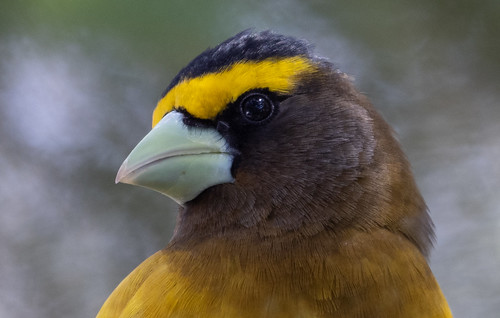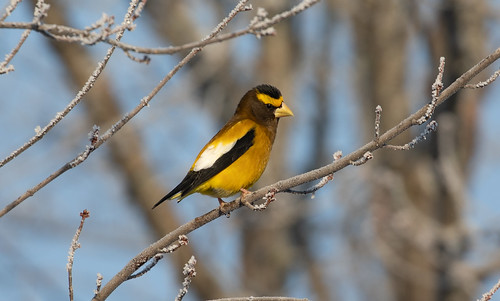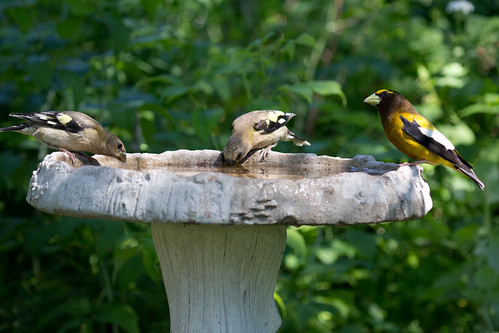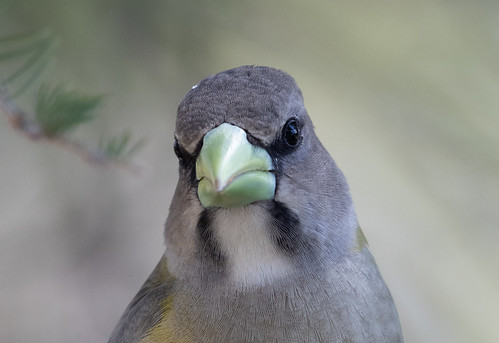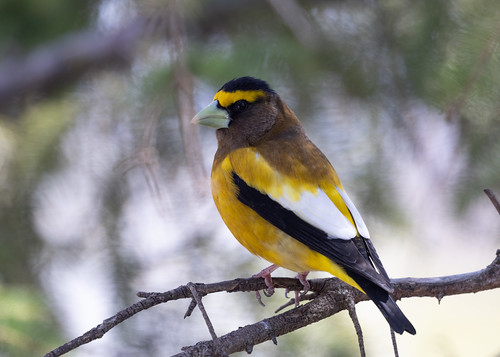On May 1, 1976, when I’d been birding for a little over a year, Russ and I went on a Michigan Audubon field trip to northern Michigan. We camped the night before in a National Forest campground so we could be at our meeting place for viewing Michigan’s last Greater Prairie-Chicken Lek before first light. From the blind, I added two lifers in addition to the prairie chicken—Upland Sandpiper and Greater Yellowlegs. After the prairie chicken flock dispersed, we went on to Hartwick Pines State Park for a breakfast stop and a short hike on which I added two more lifers—Pine Warbler and Evening Grosbeak, but I was more charmed by a Brown Creeper nest wedged into a large piece of pine bark, right at my eye level. Then we went on to Whitefish Point, where I added four more lifers—Ring-billed Gull, Osprey, Sharp-shinned Hawk, and LeConte’s Sparrow. Our group rented cabins and spent the night in Paradise, Michigan, and first thing the next morning I saw my first Long-eared Owl, just released from the Whitefish Point banding station, and before heading back to Lansing saw four more lifers—Greater Scaup, Orange-crowned Warbler, Rusty Blackbird, and Purple Finch. The weekend was so very exciting that the Evening Grosbeaks I saw at Hartwick Pines didn’t stand out particularly.
In the following years, after we moved to Madison, Wisconsin, I saw Evening Grosbeaks at my favorite Madison park, Picnic Point, and many times up in Port Wing where my in-laws bought a house and retired.
Then in 1981, Russ and I moved to Duluth. That July as we walked into our house on Peabody Street for the very first time, I added two yard birds—a Bald Eagle circling overhead, and Evening Grosbeaks calling from our trees. It took a couple of days to get our stuff organized before Russ could set out our first bird feeders. The first birds to discover it, within an hour of getting the feeders out, were chickadees and Evening Grosbeaks.
And just like that, this lovely bird became one of my top ten favorite birds of all time. During the 1980s, as my children were born and became toddlers and preschoolers, Evening Grosbeaks provided the soundtrack of our daily lives from July or August each year through May, with a few even showing up during nesting season. When the windows were open, their calls filled our house, and even when the windows were closed tightly in winter, the gentle but persistent calls somehow wafted in.
Somehow I never tired of hearing or watching them. Even before Russ and I moved to Duluth, I’d noticed how my in-laws’ Port Wing birds started developing green beaks with the first intimations of spring, right as those green-beaked birds started courting and feeding one another. Now, as family groups showed up in my yard in July and August, I watched young birds beg from green-billed birds and started realizing that the adults’ bill color reflected the period in their annual cycle when they were hormonally primed to feed either their mate or begging young. Evening Grosbeak society fully reflects the concept of it taking a village to raise a child. Once I watched a juvenile beg successfully from three different adult males in succession. I wish I'd been photographing birds at that point! I only have one photo of an adult feeding a juvenile, from 2011.
One fall, back in the 1980s when my yard was filled with hundreds of grosbeaks, I picked out a very odd individual right in my window feeder—a bird bearing male plumage on half its body and female plumage on the other half, which made it a gynandromorph. I studied it from just inches away for many minutes, but when a migrating hawk scared off the flock in a sudden frenzy, I lost sight of it.
 |
| Bilateral Gynandromorph in the Bell Museum collection, between a normal male and female. |
The Bell Museum has a handful of gynandromorph Evening Grosbeaks in their collection. Most female birds have just one functional ovary, and gynandromorphs also have one functional testis. The wing on the male side of their body measures slightly larger than that on the female side. I tried very hard to locate my living specimen again because I wanted to study how it flew to compensate for unmatched wings, but I never saw it again.
 |
| Evening Grosbeak decline in the Central states and provinces between 1967 and 2012 |
I didn’t know it when we moved here, but Evening Grosbeaks were already starting to decline in the state. The Minnesota Breeding Bird Atlas notes that their breeding numbers here dropped an average of 3.3 percent each year between 1967 and 2015, and a Partners in Flight study found a 94 percent reduction nationally between 1970 and 2014. It was heartbreaking to go from having hundreds daily in my yard for most of each year to going several years at a time without a single sighting. The one place I could count on seeing them each year has been the Sax-Zim Bog, but even those were increasingly difficult to find except at one feeding station in the northwest corner of the bog.
Russ had surgery in August 2011, and when I brought him home on August 3, he was still in a lot of pain and slept restlessly the first night. But we woke in the morning to a lovely sound—Evening Grosbeaks! A flock of 16 stayed in and near our yard every day through the end of the month, and at least four stuck around through September 6, their gentle calls balm to our souls. I got a lot of photos.
If I were keeping Top Ten lists of my best birds each year, Evening Grosbeaks would have easily made it each year of the 1980s and 2011, but not again until this year, a banner year for winter finches.
Russ and I went to the bog on January 3 and saw them not just at their one regular feeding station but at others as well. And a handful showed up in my yard in early April—I was thrilled. But then on April 25, a larger flock appeared, and they showed up every day after that until May 18. Many days I had 50 or more, with a full 250 here on April 27!
Seeing so many was thrilling enough, but they spent a lot of time in the spruce tree right next to my office and eating in my office window feeder. My baby grandson Walter got a huge kick out of them, even my dog Pip noticed them, and I went crazy photographing them.
Evening Grosbeaks were calling almost constantly, and one morning I figured out a good spot to set my equipment up to get an excellent sound recording of the birds in that nearby spruce tree. With them up close and personal and my window open, I was also hearing a little wink note I’d never noticed before, and got some recordings of that.
As spring continued to unfold, I started hoping against hope that some grosbeaks might actually nest nearby, or at least close enough that they’d reappear in July, but except for a group of 5 that showed up briefly on November 9, I haven’t seen them in my yard since May. At least I have a bazillion close up photos. I’m actually more of an auditory than visual person, so I even more treasure my 50-minute recording of them. Whenever I listen to it, my heart fills with joy.
So of course Evening Grosbeaks are in my Final Four top birds for 2021. For some reason, this is also the year that Hallmark made their annual "Beauty of Birds" keepsake ornament the Evening Grosbeak. The mass-produced ornament is a male, but they also made a limited-edition female. We don’t have a Hallmark store in Duluth anymore, but I managed to get both ornaments online. So for the rest of my life, whenever I decorate our Christmas tree, I’ll remember my lovely time with this splendid bird.
